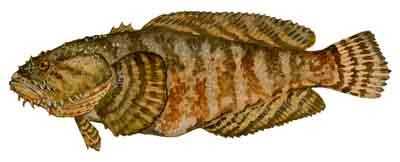Oyster Toadfish

Species Details
Opsanus Tau
Batrachoididae
Batrachoidiformes
Wrecks, reefs
3 - 5 lbs.
12" - 16"
Oyster Toadfish (Opsanus tau) Fish Description
The Oyster Toadfish are also commonly known as the ugly toad, oyster cracker, oyster catcher, and bar dog. They appear principally yellowish with an olive-brown back along with a pattern of brown blotches or sloping lines, and a pale belly.
They are scaleless and have a compressed, flattened body that can grow 12 inches lengthwise. Oyster Toadfish have ��“whiskers” or paunchy flaps on their cheeks and jaws. On top of their large, flat head are bulging large eyes accompanied by a broad mouth filled with strong, rounded teeth. They very much resemble a toad, as they are named.
But careful, Oyster Toadfish has a venomous spine on their first dorsal fin. Venom from the Oyster Toadfish has been compared to the pain levels of a bee or wasp sting.
Oyster Toadfish Diet and Size
Oyster Toadfish are omnivores. Their common prey includes the following: crustaceans, mollusks, amphipods, squid, and other smaller fish.
The length of the Oyster toadfish is about 17 inches and rarely do they grow longer than 15 inches.
Interesting Facts About The Oyster Toadfish
- The name of the Oyster Toadfish is from their likeness to toads, with their scaleless brown skin covered with thick mucus and sometimes warts.
- In comparison to any Chesapeake Bay fish, the Oyster Toadfish lays the largest eggs in the area.
- Oyster toadfish can live in rather poor conditions, being able to tolerate litter and polluted water, and can survive out of water for a lengthy period.
- Oyster toadfish are edible! But they are rarely eaten because of their off putting appearance.
- NASA, back in 1998, has sent the oyster toadfish to space in the investigation of the effects of microgravity on the development of otolithic organs.
Oyster Toadfish Fishing Techniques
When fishing for Oyster Toadfish, they can and will take on an angler's bait rather quickly. Baits like pieces of squid, clams, bloodworms, and peeler crabs would be good to lure them in. Though most anglers despised the toadfish, as they are often caught accidentally, you mustn’t throw caution out in the wind when out fishing for this one, because the Oyster Toadfish has powerful, snapping jaws and sharp, venomous spines on its dorsal fin. Not quite the gamefish you’d expect, are they?
Oyster Toadfish Habitat and Distribution
Bottom-dwelling fish, similar species such as the Oyster Toadfish are found around oyster reefs, but also inhabit areas among wreck, debris, rocks, and other dark secluded places in the shallow waters during the warmer months, but deeper in the channels in the winter.
These types of fish are in abundance throughout the year by the Chesapeake Bay; They are frequently found in the middle and lower Bay areas.
Oyster Toadfish can be also be located near the shore from Maine to Florida.







